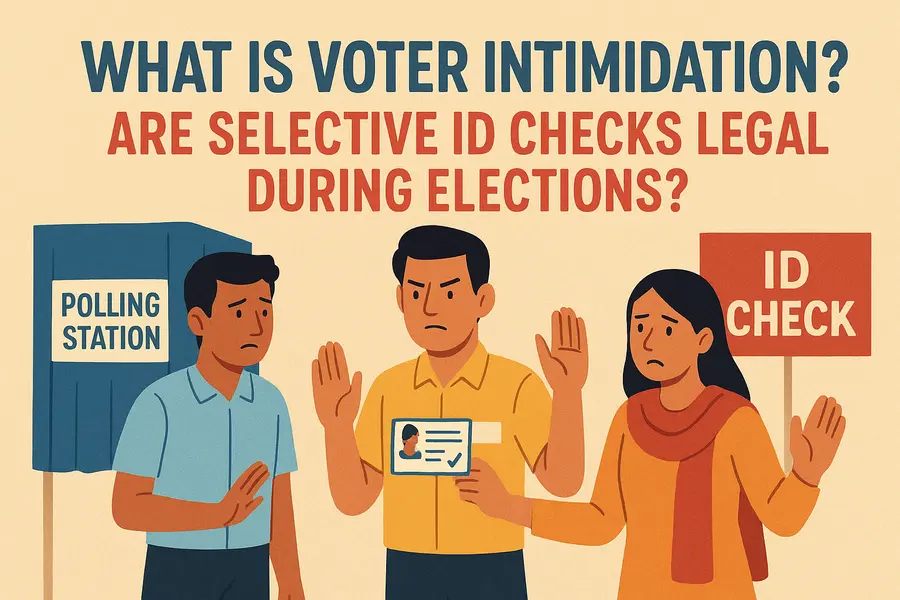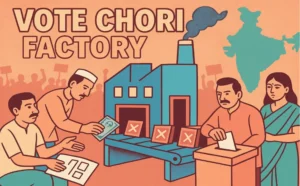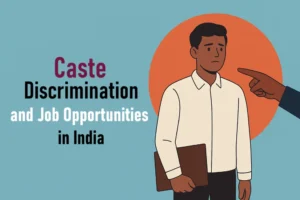Voter intimidation is a silent threat that can weaken even the strongest democracies. It includes any action—direct or indirect—that scares, pressures, or discourages citizens from voting freely.
In India, where every election reflects the voice of more than a billion people, understanding this issue becomes crucial.
One growing concern is selective ID checks, where certain voters are asked for identification while others are not. This practice may seem minor, but it can lead to discrimination and undermine the fairness of the entire process.
In this article , we will explain what voter intimidation looks like, how to identify illegal ID checks, and what legal protections every Indian voter has. Empowered voters are the strongest defense against unfair elections.

Voter Intimidation: Are Selective ID Checks Legal During Elections?
In a democracy as diverse and vibrant as India, every vote is a voice — and anything that tries to silence that voice is nothing short of a threat to the nation’s spirit.
Voter intimidation refers to any attempt—direct or subtle—to scare, pressure, or mislead citizens so they hesitate to cast their vote freely. It could be a threatening presence near a booth, selective questioning, false legal warnings, or even misinformation circulating online.
Understanding voter rights and election laws is not just a civic duty; it’s self-protection.
When citizens know what is allowed at polling stations and what counts as illegal interference, they are far less likely to be manipulated or deterred. A well-informed voter becomes harder to suppress and easier to empower.
The purpose of this article is simple yet urgent: to bring clarity, build awareness, and strengthen your legal understanding of how elections are meant to function.
In a country where millions queue up to shape the future, knowing your rights is the first step toward safeguarding your vote — and your democracy.
What Is Voter Intimidation?
Voter intimidation is any act—open, indirect, or disguised—that attempts to influence, scare, or discourage a citizen from voting freely.
In the eyes of Indian election laws, intimidation is not judged only by physical force; even psychological pressure or misinformation that interferes with a voter’s free choice qualifies as illegal.
The Election Commission of India (ECI) clearly states that no voter can be threatened, misled, or obstructed while exercising their constitutional right. This includes actions that create fear, restrict access to polling booths, or manipulate voters into believing they are not eligible to vote.
Examples are wide-ranging: a group blocking an entrance to a booth, political workers issuing verbal threats, or someone spreading false claims like “police will check criminal records at the polling station.”
Even subtle acts—like following a voter, asking intrusive questions, or using body language meant to intimidate—fall under this category.
Common forms of intimidation often appear in crowded or high-tension polling areas. Threats, harassment, or physically blocking the path to a booth are classic tactics. Sometimes, aggressors ask voters about their citizenship, address, or past legal issues to create fear.
Another tactic is impersonation—when individuals pose as election officials and demand unnecessary documents.
Even simple actions like recording voters, monitoring their movements, or standing too close to voting queues can create pressure and violate ECI norms.
In today’s digital era, intimidation has moved online. Digital intimidation includes large-scale misinformation campaigns—like viral messages falsely stating that certain IDs are invalid or that booth cameras will record votes.
Fake legal warnings circulated through WhatsApp groups create panic among first-time voters. In some areas, automated phone calls or targeted messages are used to discourage minority communities from voting.
Whether offline or online, every form of intimidation weakens democracy—and understanding it is the first step in resisting it.
Historical Context of Voter Intimidation
Voter intimidation is not a new phenomenon; it has evolved with politics itself. Across the world, powerful groups have long tried to silence voices they considered “inconvenient.”
In the early days of democracy in the United States, for instance, African American voters were threatened, blocked, or punished for trying to vote.
Similar patterns have been seen in many countries where marginalized communities—ethnic minorities, lower-income groups, or rural voters—were discouraged from participating in elections simply because their votes could shift the balance of power.
India has its own complex history. During the early decades after independence, intimidation often took the form of social pressure, caste dominance, or muscle power at polling stations.
In some regions, local strongmen dictated how entire villages voted. Over time, however, the Election Commission of India (ECI) strengthened its rules, introduced strict monitoring, deployed central forces in sensitive areas, and expanded voter protection.
These legal reforms slowly reduced the influence of brute force at polling booths, giving citizens greater confidence to vote freely.
Yet despite progress, intimidation has not disappeared. Why do these tactics persist today?
One major reason is growing political polarization, where rival groups see elections not as civic participation but as a high-stakes battle. This creates an environment where some actors believe fear is a legitimate tool.
A second reason is the lack of voter education. Many citizens are unaware of their rights, making them easy targets for misleading claims, unnecessary ID checks, or pressure from local influencers.
Weak enforcement mechanisms allow intimidation to survive. Laws exist, but on-ground implementation can be inconsistent, especially in remote or densely populated regions.
Understanding this history helps us recognize intimidation not as isolated incidents but as part of a long struggle to protect the integrity of the vote.
Are Selective ID Checks Legal During Elections?
Selective ID checks during elections may seem harmless, but they can quietly undermine the fairness of the entire democratic process. Understanding how ID verification works—and when it becomes discriminatory—is essential for protecting every citizen’s equal right to vote.
What Are ID Checks at Polling Stations?
ID checks are routine steps used to verify a voter’s identity and ensure the name on the electoral roll matches the person present. Election officers follow fixed procedures issued by the Election Commission of India (ECI), using an approved list of identity documents. Their role is not to judge eligibility but to confirm identity efficiently, respectfully, and uniformly for all voters. This step safeguards the integrity of voting without causing unnecessary delays or harassment.
Understanding Selective ID Checks
Selective ID checks occur when officials or polling agents demand identification only from specific individuals or groups—often based on appearance, gender, religion, caste, or perceived political leanings. This practice is discriminatory because it creates unequal treatment and discourages targeted voters from participating. It signals that some citizens are viewed as “suspicious” while others are not. Such biased verification not only violates democratic principles but can also amount to voter intimidation.
Legal Position in India
Indian election laws allow ID verification, but only when applied uniformly. Polling staff cannot demand ID selectively or impose conditions beyond ECI guidelines. The presiding officer ensures fairness and can request ID from all voters if necessary—never from a chosen few. Selective checks based on personal judgment or bias are strictly prohibited and can attract legal action. The law’s intention is clear: every voter must be treated equally at every polling station.
International Legal Perspective
Across democratic nations, equal treatment at polling stations is a fundamental norm. Countries emphasize uniform ID requirements to prevent discrimination and maintain trust in elections. Unequal or selective checks are viewed as forms of voter suppression, especially against minorities. Ensuring identical procedures for every voter protects the credibility of the process and reinforces the basic democratic promise: each individual’s vote holds equal value, regardless of identity or background.
Signs That Selective ID Checks May Be Illegal
Selective ID checks often hide behind the appearance of “routine verification,” but a closer look reveals clear warning signs that something is not right.
One major red flag is when only certain voters—perhaps identified by their religion, caste, age, gender, or even clothing—are asked to show ID while others walk through freely. This unequal treatment suggests bias, not procedure.
Another sign is when polling staff or agents begin demanding documents not required by the Election Commission of India (ECI). If they insist on a particular ID, reject valid alternatives, or act as though only one form is acceptable, it indicates a violation of official guidelines.
Some intimidators take it further by discouraging or diverting voters who they claim “don’t have the right ID,” even when those voters hold legally acceptable documents. This tactic aims to reduce turnout from specific groups.
The most serious warning is threatening voters with legal consequences, such as arrest or verification by police, if they cannot produce unnecessary documents. These threats are unlawful and designed to create fear. Recognizing these signs empowers voters to protect their rights.
Read Here: The Impact of Social Media on Political Participation
What Voters Should Do If They Face Intimidation or Illegal ID Checks
Facing intimidation at a polling booth can be unsettling, but voters hold more power than they often realize. The first rule is simple yet crucial: stay calm.
Panic benefits the intimidator, not the voter. If something feels wrong—like unnecessary ID demands or hostile behaviour—quietly document the incident.
Note the time, booth number, description of the person involved, and, if safe, take a discreet photo or audio note. This evidence becomes valuable when reporting.
Next, approach the presiding officer, the highest authority inside the polling station. Their duty is to ensure smooth, lawful voting.
Explain what happened and request immediate corrective action. Under Indian election law, every voter has the right to cast their vote without obstruction or harassment. No one—neither polling agents nor unofficial volunteers—can deny that right.
If the issue persists, use the official reporting mechanisms. The Election Commission of India provides helplines where complaints can be registered instantly.
Many regions also support digital tools like cVIGIL, which allows voters to upload evidence and alert authorities in real time.
You can also inform local police officers stationed near the booth or approach election observers if present. These officials are trained to respond quickly to misconduct.
Most importantly, ensure your vote is counted. If an officer claims your ID is insufficient, politely point out that the ECI accepts multiple valid documents.
Ask them to verify your name on the electoral roll and provide alternative identification if needed. If staff continue to refuse, request escalation to the sector officer or returning officer.
Your vote is your voice—firm, lawful insistence is often enough to protect it. Intimidation works only when voters stay silent; when they stand their ground, democracy stands with them.
Role of Election Officials and Observers
Election officials are the backbone of a fair polling process, ensuring every voter experiences a smooth and lawful election.
Polling staff are responsible for verifying voter identity, guiding people through the voting procedure, maintaining order at booths, and ensuring all steps follow the Election Commission’s guidelines. Their job is not to judge voters but to assist them, protect their rights, and prevent any form of intimidation or discrimination.
Alongside them, election observers act as neutral watchdogs. Appointed by the Election Commission, they monitor the polling environment, watch for misconduct, and intervene when rules are violated.
Observers often conduct surprise inspections, speak to voters, and record any irregularities. Their presence alone discourages misuse of power and helps maintain transparency.
To reinforce fairness, strong accountability measures are in place. Officials who misuse authority can face disciplinary action, removal from duty, or legal consequences.
Complaints filed by voters are formally reviewed, creating a system where no misconduct goes unchecked.
Together, officials and observers uphold the integrity of the democratic process, ensuring every vote is protected.
Preventive Measures Against Voter Intimidation
Preventing voter intimidation is not just a government responsibility—it is a collective effort that strengthens democracy from the ground up.
The most powerful shield is awareness. When citizens understand their voting rights, recognize illegal behaviour, and know how to report it, intimidation loses its sting.
Awareness campaigns—through media, schools, community meetings, and digital platforms—help voters walk into polling booths with confidence, not fear.
Equally important is strict legal action against offenders. When those who threaten or mislead voters face real consequences—fines, arrests, or disqualification—it sends a strong message that elections are a protected space. Visible enforcement builds trust and deters future offenders.
Community organizations also play a vital role, especially in vulnerable or marginalized areas. They assist first-time voters, accompany elderly or anxious citizens, and provide helplines or volunteers to offer support. Their presence reassures voters that they are not alone.
Modern surveillance and transparency tools add another layer of protection. CCTV setups at sensitive booths, mobile apps for whistleblowing, live monitoring rooms, and independent observers help detect and document misconduct instantly.
When every action is watched, recorded, and traceable, intimidation becomes much harder to hide—and easier to punish.
Conclusion
Free and fair elections are the heartbeat of any democracy, and India’s strength lies in every citizen being able to vote without fear, pressure, or discrimination.
When the voting process is clean, transparent, and accessible to all, the true will of the people is reflected—and that is what gives a nation its legitimacy.
But protecting this process is not the Election Commission’s job alone. Voters must stay aware, informed, and alert to signs of intimidation or selective ID checks.
When something feels off, reporting it immediately—whether through helplines, observers, or digital tools—helps stop small violations from becoming larger threats.
Above all, elections must treat every voter the same. No one should be singled out because of their identity, background, or appearance.
The law guarantees equal protection, and enforcing this principle ensures that every vote has equal value.
A strong democracy isn’t built only on ballots—it is built on citizens who know their rights and are ready to defend them.





